How to overcome the German mine blast barriers during the war
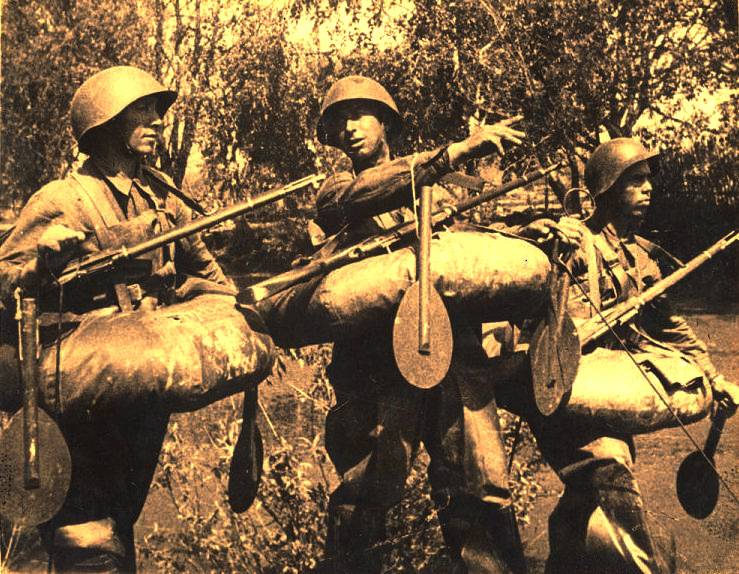
Before the attack on the USSR and in the first months of the war, the German command believed that mines and land mines could be used only as a means of reinforcing non-explosive barriers. However, already in the period of defensive battles that our forces forced to lead the fascists at the end of 1941 and in 1942 in separate strategic directions, the Wehrmacht command took a number of measures aimed at developing new types of mine-explosives. Later, when the Soviet troops launched an offensive on the entire front, in order to increase the sustainability of their defenses, the Germans launched mass production of mines and the creation of mine-explosive barriers (MVZ) on their defensive lines. In 1943, the German army was armed with six types of anti-tank mines (PTM) and three types of anti-personnel mines (APM). The construction of the enemy barrier system was improved, its structure was complicated. If in the first period of the war the density of its minefields was 1-2 mines per 1 linear meter, then it has increased significantly since 1943. At the same time, the shape and depth of minefields also changed, reaching 100 m. They had a predominantly rectangular shape and were created before the first, second, and sometimes before the third trenches of the first position of the main German defense line.
As you can see, if in the first period of the war in the German army, mines were considered to be essentially barrages of the “second grade,” then, taking into account the experience of battles, including our troops, their use was carried out in large quantities. Overcoming the barrier system created by the enemy cost a lot of effort from the troops leading the offensive in engineering, technical and organizational terms. It was necessary to improve the available means and methods of arranging the passages in the mine-explosive barriers and to create new ones that best met the requirements of the battle. At the same time, more effective methods were worked out for commanders (commanders), combined-arms staffs and chiefs of engineering troops to organize obstacles overcoming.
In the prewar years, the RKKA studied and practically developed individual means, methods and the organization itself to overcome the cost centers. By the beginning of the war, VIM-210 mine detectors, improvised probes and various detonation devices were used as means of reconnaissance and demining of minefields in our engineering troops. In practice, the method of making passages in the cost center was manual using probes, mine detectors, and sometimes explosives. Conducted research and experiments to develop other, more advanced ways of making passes in the cost center: artillery fire, roller trawls, using the track bridges. However, by the beginning of the war, they were not sufficiently developed.
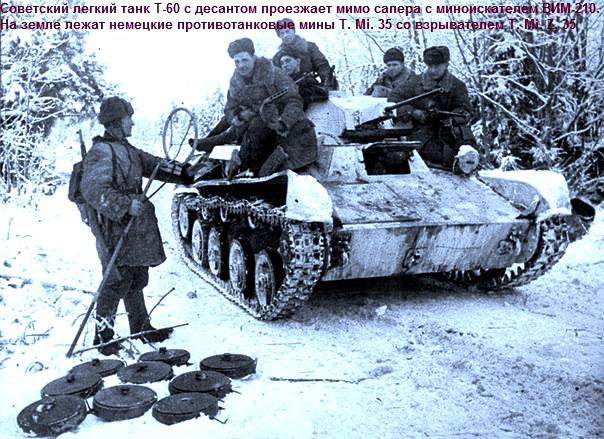
The Red Army at the beginning of the war led heavy defensive battles, so the focus of scientific thought and rationalizers of engineering troops was focused on developing and finding ways to most effectively use various obstacles, rather than overcoming them. In addition, the insufficient development of means and methods of demining was caused by the fact that the enemy used relatively few mine-blasting barriers when conducting defensive actions.
In the second period of the war, when our troops began to conduct large-scale offensive operations, and the enemy was forced to switch to the widespread use of the cost center at their defensive lines, one of the main tasks of engineering support for the breakthrough and the offensive was to provide passages in minefields. In the autumn of 1943, engineering troops received more advanced mine detectors (VIM-203, VIM-203M), and the explosive method of creating passages was more often used. The PT-3 anti-mine trawl was created. At the suggestion of his designer lieutenant colonel P.M. Mugalev first formed an experimental engineeringtank the unit that laid the foundation for the creation of engineer-tank regiments equipped with mine sweeps.
The engineering forces in the last period of the war already had a whole range of means of reconnaissance and overcoming the cost centers. The miners VIM-625, VIM-625В, the extended explosive charge UZ-1, the anti-mine trawl ПТ-3, a set of devices and devices for reconnaissance of slow-acting mines (SLM), probe of Vladimirov, a device for listening to watch movements in the LSM and etc. For the control check of the mining area, specially trained mine detection dogs were used.
Very significant changes occurred in organizational and staff relations. Assault engineering-sapper brigades appeared in the engineering troops, separate tank-engineer regiments, the most important task of which was to provide passages to the cost centers and to participate directly in the assault of the firing facilities when the enemy defensive lines were broken through. For demining the territory of the liberated regions of the country, by order of the Supreme Command Headquarters, in February 1943, five rear guard brigades were formed, each of which consisted of five to seven engineering battalions, and in March, the formation of battalions of mine detection dogs began.
The presence of new means of mine clearance and extensive combat experience of the troops to overcome the cost centers made it possible to improve the manual way of making passes, practically use and develop explosive and mechanical (trawling) methods, and also look for other ways to arrange passes.
Most often during the war years used the manual method. From the engineering and sapper units formed a special grouping. Depending on the nature of the barriers and the required passage width (from 5-6 m to 10 — 12 m for infantry and to 20 — 30 m for armored vehicles), up to one or two engineer divisions were assigned to the group. Equipped groups equally in almost all 1944-1945 operations. Thus, the group razgrazhdeniya 37-th Engineering Brigade of Engineers 69-th Army in breaking the enemy's defensive line to Puławy bridgehead in service had 1-2 mine detector, 3-4 probe, 1-2 scissors to cut the wire, set to indicate visually minutes, pointer tape to mark the passage, 2-3 cord with "cats" for pulling mines, a set of checks to fuses, wearable entrenching tools. Sometimes there were two hundred gram tolovye drafts and incendiary tubes.
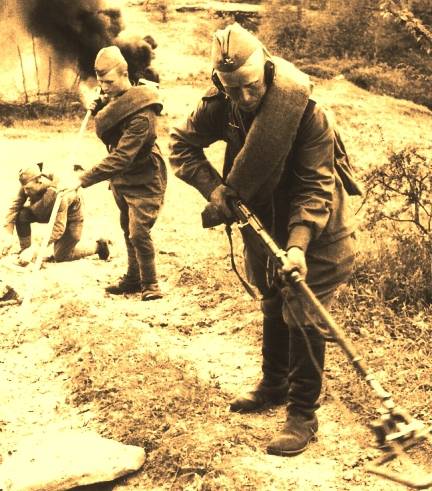
At the end of the second and third periods of the war, most often the device passes through the minefields in an explosive manner that was much more progressive and more reliable than the manual one. It was used for making passages in combined minefields, in the presence of anti-sluggishness elements in anti-tank mines, or in difficult weather conditions (snow cover, icing, etc.). Clearance of passes was carried out using overhead concentrated, suspended and impelled concentrated, elongated and even metered explosive charges. With the explosive method, it was not necessary to determine the location of each mine (except in cases of mines exploding by surface charges), it was only important to know the boundaries of the minefield. In the role of overhead charges used mainly dvuhsotgramovye TNT checkers, laid on the surface of the camouflage layer mines. Sometimes they were interconnected by a detonating cord to create a group charge. During the war, concentrated suspended charges of explosives were found to be used, requiring less time to prepare for the passage in their cost centers. In preparation for the blockade breakthrough on the Leningrad front, at the beginning of 1943, the night before the attack, more than 1000 suspended charges were installed above our minefields. With the beginning of artillery preparation they were blown up. As a result, complete demining occurred.
On some fronts, experimental work was carried out to improve the manual and other methods. At the end of the 1944 of the year, on the 2 of the Belorussian Front, it was determined that for a passage device on explored terrain, having an area of the order of 100 square. m, requires 60-80 kg BB and 3-4 hours of work of the demining unit. In the engineering troops of the 1 of the Ukrainian Front, when conducting the Vistula-Oder operation, mobile (on single-axle bogies) concentrated charges with explosives 60-80 kg were used. The charge with the help of a rod supported by wheel supports was fed forward to 70-80 m. The experiment showed that the explosion of such a charge formed a passage in the minefield with a depth and width up to 20-25 m.
However, as experience has shown, it was more perfect to make passes with the help of elongated charges (US) of explosives. In the first two periods of the war, UZ was prepared in subdivisions most often using 400-gram TNT sticks tied to a pole (bar). The length of the charges - from one meter or more. Initially, the passage with the use of ultrasound was performed sequentially, i.e., having blown up one charge, laid down and undermined the next. The width of the passage in the minefield in this case was about 2 m.
Later, suspended ultrasound on tripods up to a meter in height began to be used, which made it possible to increase the aisle width to 8 m. However, both methods of installing an ultrasound on the field had drawbacks: the preparation time for the explosion was lengthened and the secrets of the sappers from observing the enemy were violated.
At the end of the war, when the service elongated charges (USN-1) appeared in the engineering troops, their delivery to the minefield began to be made on carts. This required that the surface of the earth was relatively flat and solid. A large passage width was achieved by parallel laying and undermining of several elongated charges.
It should be noted that the principle of using mobile UZ was developed in foreign armies after the war. Charges delivered to the field using jet engines were developed. Ultrasounds were used during the war (by sliding them with tanks) to broaden the aisles made with the help of the track mine trawls attached to the tanks. The combat experience of making passages in the cost center by trawling tanks with trawls PT-3 was first obtained in the Kiev operation in November 1943 of the year. Following the artillery preparation, the 1 Engineer Tank Regiment, which was part of the shock group of the 166 of the Ukrainian Front, began its advancement from the starting line to the leading edge of the German defense. In the footsteps of trawls and tracks of tanks, linear tanks and rifle subunits moved. The non-stop movement of the advancing units through the barriers was a complete surprise to the enemy.
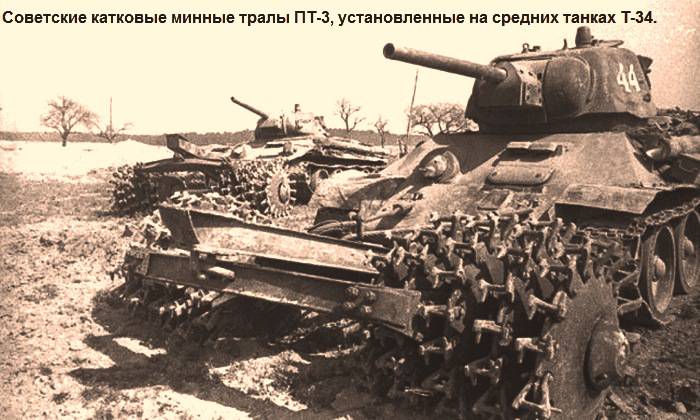
This experience has shown that the new method can be very effective if the attacking tanks simultaneously move along the aisles. However, its use required the massive use of tanks with trawls. Therefore, already in the summer of 1944, five such regiments acted simultaneously in the Belorussian operation in the breakthrough areas of the 6 th Guards, 5 th, 11 th Guards, 3 th and 28 th armies. These units basically fulfilled the task, however, the experience of their use in wooded and marshy areas revealed a number of shortcomings that reduced the effectiveness of actions, and in some cases led to combat losses. Most often this was observed where tanks with trawls followed in small groups along warm areas, without sufficient organization of interaction with linear combat vehicles. Conversely, if they were used massively, closely interacted with linear tanks, artillery and infantry, moving along roads or on a relatively solid surface, success was obvious.
By the end of the war, methods of actions of the tank-engineer regiments were basically worked out when arranging the aisles. With three companies (a total of 20 tanks with PT-3 trawls), the regiment usually operated on the front to 2-3 km. A company of minesweepers with a sapper platoon provided access through the aisle of a tank regiment. Since the beginning of the attack, the trawling tanks, as a rule, moved in pairs in the intended directions and fouled a strip in width in 4,8. At the same time, tanks with trawls followed a ledge, one after another at a distance of 15-25. For the infantry, rut passages were made (one tank with a trawl), which could then be expanded by the sappers using UZ.
The scope of tasks for arranging passes in the cost centers of tank-regiments and ensuring the passage of linear tanks is seen from the following example. At the beginning of the Vistula-Oder operation of the 1 of the Byelorussian Front, the 166 Engine and Tank Regiment made four passes across the 4,8 m and six track lines; The 92 Engineer Tank Regiment is six and four respectively. For them, without losses, the cost centers overcame two tank brigades, four heavy tank regiments, and three regiments of SAU.
Thus, a new method of arranging passages in the cost center (trawling with tanks and trawls) during the war years was quite effective and was further developed in the postwar period. In addition to the roller trawls, there were knife, used as an individual means of each battle tank. In this case, you can successfully solve the main task - ensuring the massive use of tanks in breaking through the enemy defenses, saturated with mine-explosive obstacles.
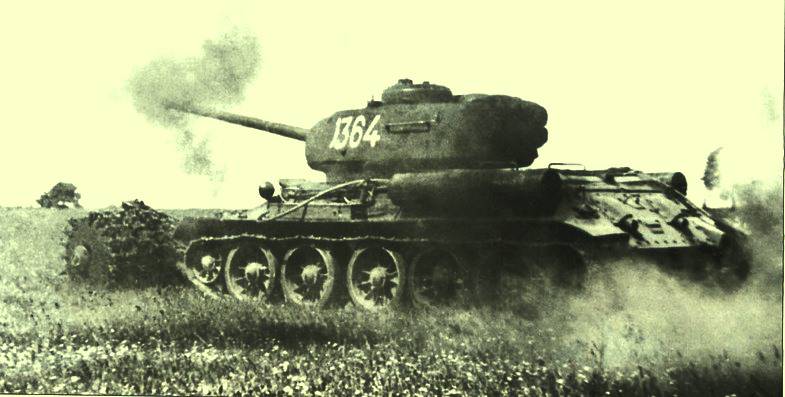
During the war, experiments were continuously conducted on the use of fire to make passes in the cost center. Experimental checks were carried out on different fronts. For example, in the 2 band of the Guards Army operating in the spring of 1944 in the Crimea, a minefield (100 anti-personnel mines of the PMD-6 type and 50 anti-tank mines of the T-55 type) fired from 120-mm mortars. 128 explosions of mines that fell within the minefield only 7 anti-tank mines exploded, and anti-personnel mines remained operational, although 30 of them were pierced by shrapnel. Many such experiments in 1944 showed that this method of making passages to the cost center was unreasonable, especially since after the shelling the field became dug, the mines were thrown by the soil, and it was almost impossible to find them among the fragments using a mine detector.
Other methods were also tested, for example, using a detonating cord grid, bridges for infantry passage. However, with the development of mine-explosives, the improvement of the barrier system itself, such methods turned out to be ineffective at that time and did not receive the right to use.
In organizing the overcoming of the cost centers, the joint work of commanders, staffs of combined-arms units and formations, operational units and engineering commanders of all degrees is important. The experience of the Great Patriotic War showed that the commanders (combined arms commanders) personally dealt with the choice of methods, determining the necessary number and time to make passes at the breakthrough sites, the procedure for overcoming obstacles by attacking troops, and organizing interaction. The basis for solving these issues was the proposals of the head of the engineering troops, which were reported during the development of the decision or during the reconnaissance carried out by the commander. In addition, special directives, orders and instructions to troops were often developed. For example, in January 1944, in order to ensure the correct organization of enemy defense breakthroughs, a directive signed by the commander, member of the military council and chief of staff of the 4 Ukrainian Front gave instructions on the number of passes in various obstacles, their width, order and content.
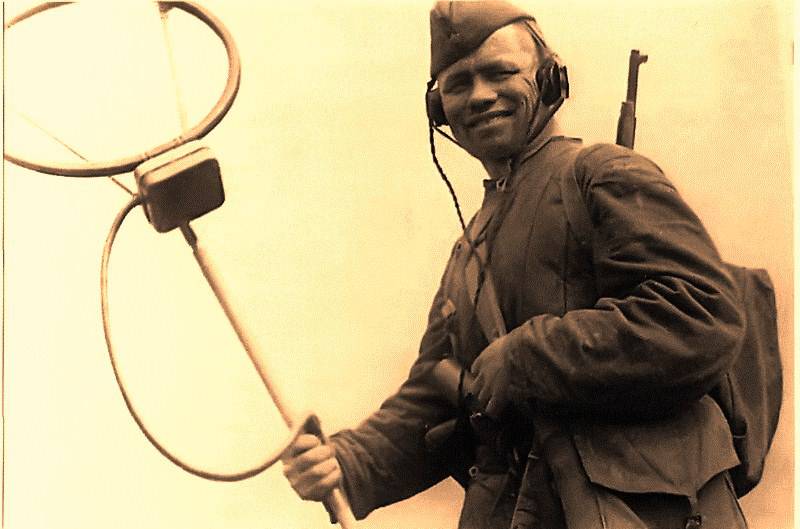
In practice, the passages in their barriers were arranged for two or three days before the offensive, and in the enemy barriers on the night before the offensive, and ended during the artillery preparation. Often, at the breakthrough sites, our barriers were removed completely, and those that were in the depth, were fenced or also removed, in order to rule out the undermining of equipment and personnel. The following data speaks about the scale of the tasks performed for arranging passes. In the Vistula-Oder operation, in the 1 of the Byelorussian Front, 1170 passes were made in ours and 872 in the German minefields. In total, 42407 PTM and 17955 APM were shot in their minefields, and in German - 19483 and 14201, respectively.
In modern conditions, as experts who study the experience of local wars, mine-explosive barriers have been further developed, their systems have become more complex and effective. Areal mining is widespread. In the presence of remotely installed minefields, successfully overcoming them requires not only improving traditional methods of arranging aisles, but also searching for new techniques that are more relevant to modern requirements, as well as more active participation of all branches of troops.
Sources:
Kharchenko V. ... Special Purpose. M .: Voenizdat, 1973. C. 3-31, 147-156.
Tsirlin A., Biryukov P. Istomin V., Fedoseyev E. Engineers in the battles for the Soviet homeland. M .: Voenizdat, 1970. C. 152-157.
Soskov, A., Development of Means and Methods for Making Passages in Mine-Explosive Barriers during the War / / VIZH. 1984. No.4. C. 14-19.
Biryukov P. Engineering troops. M .: Voenizdat, 1982. C. 48-54.
Information